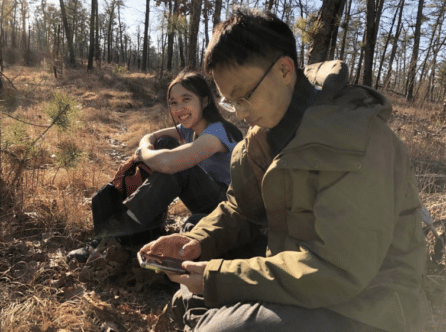What Makes You Smell Tasty to a Mosquito? And How Do They Hunt You Down?
NewsThe Context: Mosquitos – everyone’s least favorite barbecue guest – are notorious superspreaders for diseases like Zika, dengue, and yellow fever. Scientists know that in some parts of the world, they hunt down humans almost exclusively to fulfill their unending bloodlust. What’s not well understood is how they manage to target us so precisely.
The Study: Mosquitos pick up on two chemicals (called decanal and undecanal) in human odors to pinpoint us, and two structures in a part of the brain called ‘glomeruli’ – part of the smell sensing system – allow them to do so, finds a new study in Nature by NYSCF – Robertson Neuroscience Investigator Lindy McBride, PhD, of Princeton University.
The Importance: This study identifies the system by which mosquitos recognize and prefer humans over animals, and opens the door for strategies to mask ourselves from them or lead them into traps, helping curb spread of disease (and bites!)
“We set out to try to understand how these mosquitoes distinguish human and animal odor, both in terms of what it is about human odor that they cue in on and what part of their brain allows them to cue in on those signals,” said Dr. McBride, an Assistant Professor of Ecology and Evolutionary Biology and Neuroscience.
“We sort of dove into the brain of the mosquito and asked, ‘What can you smell? What lights up your brain? What’s activating your neurons? And how is your brain activated differently when you smell human odor versus animal odor?’”
Inside a Bloodsucker’s Brain
To answer these questions, the team knew they needed a way to see inside a mosquito’s teeny, 3 millimeter brain. They genetically engineered mosquitos so that their brains lit up when active, and observed them through a custom-built microscope as they were surrounded by human or animal-flavored air.

They collected animal odor from hair, fur, and wool samples from quite an eclectic group of critters: two rats, two guinea pigs, two quail, one sheep, and four dogs. These came in the form of donations from local farms, and in the case of the dogs, some clippings from a slightly confused but agreeable PetSmart groomer.
As for the 16 human odor samples used in the experiment, collection was a bit more involved.
“For the human samples, we had a bunch of great volunteers,” remarked graduate student Jessica Zung. “We had them not shower for a few days, then strip down naked and lie down in a Teflon bag.”
Um…did they really have to be naked? Yes. Fibers from our clothing have a smell too, and the team needed to be sure the odor they were capturing was 100% unfiltered, unwashed human (we know, ew).
The researchers found that human odor has two chemicals that are enriched: decanal and undecanal. The team patented a special blend featuring decanal – essentially making an appetizing, irresistible perfume – that they hope could be used to lure mosquitos into traps or develop repellants.
An Evolutionarily Elegant System
Once the team started looking at the mosquito brains to see how they responded to the odors, they were shocked. They assumed that the precise task of detecting humans would require an intricate dance between many brain structures called ‘glomeruli’ that reside in the smell-detecting part of the brain. In reality, it’s a tango between just two.
“The simplicity surprised us,” admitted Dr. McBride. “Despite the complexity of human odor, and the fact that it doesn’t really have any kind of human-specific compounds in it, the mosquitoes have evolved a surprisingly simple mechanism for recognizing us. To me, it’s an evolutionary story: if we created a statistical test to differentiate human odor, it would be very complex, but the mosquito does something remarkably simple, and simple usually works pretty well, when it comes to evolution.”
“When I first saw the brain activity, I couldn’t believe it — just two glomeruli were involved,” Zhilei Zhao, PhD, an alumnus of Dr. McBride’s lab, remarked. “That contradicted everything we expected, so I repeated the experiment several times, with more humans, more animals. I just couldn’t believe it. It’s so simple.”
It seems one of the glomeruli in the mosquito brain responds to a range of smells, including human odor, and the other responds only to humans. Together, they make for an expert tracking system.
The team attributes the strength of their findings to the integration of several strategies and a team science approach.
“If this were purely a neuro imaging paper, there would be some questions remaining,” noted Dr. Zung. “If this were purely an odor analysis paper, there would still be unanswered questions. A purely behavior paper, same thing. But one real strength of this project is that we were able to bring in so many different methods and the expertise of so many people. And Lindy was just amazing and willing to learn about and invest in all these different methods.”
“This entire project is incredibly collaborative,” Dr. Zhao agreed. “We were tackling so many lines of evidence that have now converged into a cohesive story, and that requires so much different expertise. I hadn’t studied any neuroscience before I came to Princeton, but we have the Princeton Neuroscience Institute here, with so many talented people I could learn from. For the odor science part, I have no background in that, but Jessica is an expert. And for the wind tunnel setup, we collaborated with researchers in Sweden. If we had done everything ourselves, we might not have gotten such good results; it’s only through collaboration that we got here.”
Journal Article:
Mosquito brains encode unique features of human odour to drive host seeking
Zhilei Zhao, Jessica L. Zung, Annika Hinze, Alexis L. Kriete, Azwad Iqbal, Meg A. Younger, Benjamin J. Matthews, Dorit Merhof, Stephan Thiberge, Rickard Ignell, Martin Strauch & Carolyn S. McBride. Nature. 2022. DOI: https://doi.org/10.1038/s41586-022-04675-4
Cover photo credit: Sameer A. Khan

